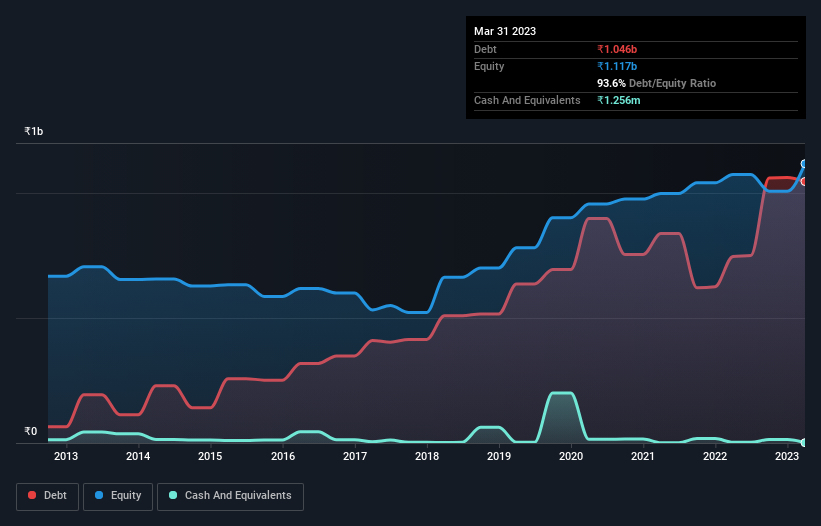
Some say volatility, rather than debt, is the best way to think about risk as an investor, but Warren Buffett famously said that 'Volatility is far from synonymous with risk.' So it might be obvious that you need to consider debt, when you think about how risky any given stock is, because too much debt can sink a company. Importantly, Hind Rectifiers Limited (NSE:HIRECT) does carry debt. But should shareholders be worried about its use of debt?
Why Does Debt Bring Risk?
Generally speaking, debt only becomes a real problem when a company can't easily pay it off, either by raising capital or with its own cash flow. If things get really bad, the lenders can take control of the business. However, a more common (but still painful) scenario is that it has to raise new equity capital at a low price, thus permanently diluting shareholders. Of course, debt can be an important tool in businesses, particularly capital heavy businesses. The first thing to do when considering how much debt a business uses is to look at its cash and debt together.
Check out our latest analysis for Hind Rectifiers
What Is Hind Rectifiers's Debt?
As you can see below, at the end of March 2023, Hind Rectifiers had ₹1.05b of debt, up from ₹746.4m a year ago. Click the image for more detail. Net debt is about the same, since the it doesn't have much cash.

A Look At Hind Rectifiers' Liabilities
Zooming in on the latest balance sheet data, we can see that Hind Rectifiers had liabilities of ₹1.51b due within 12 months and liabilities of ₹297.4m due beyond that. Offsetting these obligations, it had cash of ₹1.26m as well as receivables valued at ₹719.5m due within 12 months. So its liabilities outweigh the sum of its cash and (near-term) receivables by ₹1.08b.
Since publicly traded Hind Rectifiers shares are worth a total of ₹5.66b, it seems unlikely that this level of liabilities would be a major threat. Having said that, it's clear that we should continue to monitor its balance sheet, lest it change for the worse. When analysing debt levels, the balance sheet is the obvious place to start. But you can't view debt in total isolation; since Hind Rectifiers will need earnings to service that debt. So when considering debt, it's definitely worth looking at the earnings trend. Click here for an interactive snapshot.
Over 12 months, Hind Rectifiers made a loss at the EBIT level, and saw its revenue drop to ₹3.6b, which is a fall of 3.5%. We would much prefer see growth.
Caveat Emptor
Importantly, Hind Rectifiers had an earnings before interest and tax (EBIT) loss over the last year. Indeed, it lost ₹8.1m at the EBIT level. Considering that alongside the liabilities mentioned above does not give us much confidence that company should be using so much debt. So we think its balance sheet is a little strained, though not beyond repair. Another cause for caution is that is bled ₹212m in negative free cash flow over the last twelve months. So to be blunt we think it is risky. The balance sheet is clearly the area to focus on when you are analysing debt. However, not all investment risk resides within the balance sheet - far from it. For example, we've discovered 5 warning signs for Hind Rectifiers (2 can't be ignored!) that you should be aware of before investing here.
Of course, if you're the type of investor who prefers buying stocks without the burden of debt, then don't hesitate to discover our exclusive list of net cash growth stocks, today.
Valuation is complex, but we're here to simplify it.
Discover if Hind Rectifiers might be undervalued or overvalued with our detailed analysis, featuring fair value estimates, potential risks, dividends, insider trades, and its financial condition.
Access Free AnalysisHave feedback on this article? Concerned about the content? Get in touch with us directly. Alternatively, email editorial-team (at) simplywallst.com.
This article by Simply Wall St is general in nature. We provide commentary based on historical data and analyst forecasts only using an unbiased methodology and our articles are not intended to be financial advice. It does not constitute a recommendation to buy or sell any stock, and does not take account of your objectives, or your financial situation. We aim to bring you long-term focused analysis driven by fundamental data. Note that our analysis may not factor in the latest price-sensitive company announcements or qualitative material. Simply Wall St has no position in any stocks mentioned.
About NSEI:HIRECT
Hind Rectifiers
Engages in the designs, development, manufacture, and marketing of power semiconductor devices, power electronic equipment, and railway transportation equipment in India and internationally.
Outstanding track record with adequate balance sheet.
Market Insights
Community Narratives



